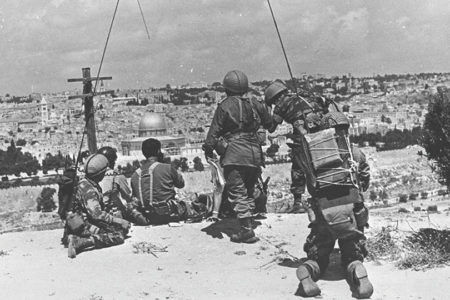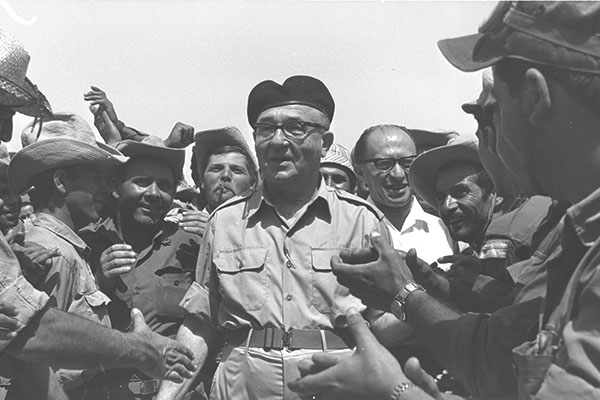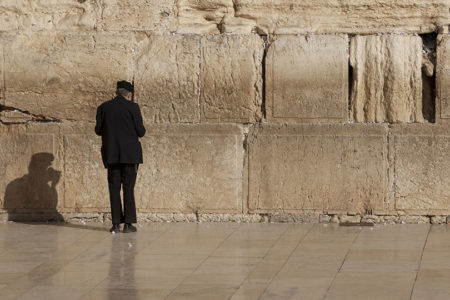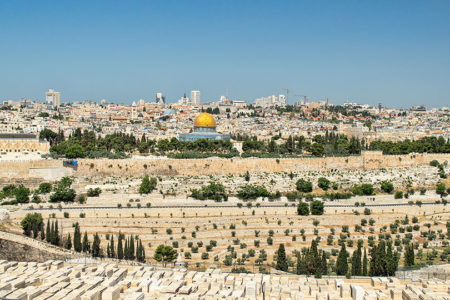The Modern Emergence of Jerusalem in the Last Hundred Years
The ancient rabbis said, “Ten measures of beauty descended to the world. Nine were taken by Jerusalem and one by the rest of the world.” In addition, it was said, “He that hath not seen Jerusalem in its beauty hath not seen a beautiful city.” Today’s Jerusalem is not only a beautiful city, it is a city of great importance to three of the world’s major religions. Observant Muslims and Christians make pilgrimages to holy sites there. For its Jewish residents, the city is a place of great reverence—the heart and soul of the nation. It has been said of modern Israel, “Tel Aviv plays, Haifa pays, and Jerusalem prays.”
Another aspect of Jerusalem that is not so beautiful is expressed in another saying of the rabbis: “Ten measures of suffering were sent by God upon the world, and nine of them fell on Jerusalem.”1
For centuries, just a handful of people lived there, including a small Jewish population. Yet, from biblical times, when the Psalmist wrote, “If I forget thee, O Jerusalem, let my right hand forget her cunning” (Ps. 137:5), there has been a longing in the Jewish heart for this ancient city of God, which will one day assume the prominent status foretold by the prophet: “Thus saith the Lord Gᴏᴅ: This is Jerusalem; I have set her in the midst of the nations and countries that are round about her” (Ezek. 5:5).
A hundred years ago it would have been easy to understand the ancient rabbinical statement about the suffering of Jerusalem. Four thousand years of history cried out with bloodshed, violence, and suffering. It would have been difficult to imagine any beauty at all a hundred years ago. In the last century, three different nations have ruled Jerusalem. For 19 of those hundred years, the city was divided between the Israelis and the Jordanians. But through the suffering, difficulties, and divisions, Jerusalem has emerged as a splendid, fascinating, dynamic city. This article examines this emergence—the powerful personalities, the political exploits, the physical development, and the growing population.
Jews have always had a presence in this city, although after the destruction of the Temple and the expulsion of the Jews in 70 A.D., they were never a majority. By 1870, however, more than 9,000 of the 18,000 inhabitants of Jerusalem were Jewish. From that time on, the city’s future was affected far more by the diaspora—Jews living outside of Israel—than by those whose families had stayed in the land through the centuries.
One such man was Moses Montefiore, a Jewish banker from England who had visited Israel (then called Palestine) seven times. Sometimes referred to as “the founder of modern Jerusalem,” he gave substantial amounts of money to finance the improvement of the city’s water supply, an essential step to its growth and development. When Montefiore died, a memorial kind was established to finance construction of entire districts. Anyone wishing to build could acquire a loan. In Yemin Moshe (all new districts were named “Moshe” in his honor), a suburb in the western part of the city, a windmill still stands today to honor his memory.
While Montefiore gave financial support, others gave scholarly support. Polish-born Leon Pinsker was one of the first Jews to attend Odessa University. He studied law, only to learn that, as a Jew, he could never practice the law in Poland. Pinsker then attended medical school at the University of Moscow and became a physician in Odessa. Greatly affected by the pogroms there in the early 1800s, he wrote a book entitled Auto-Emancipation (Freeing Oneself). Pinsker believed that the Jewish people could free themselves from anti-Semitism only by establishing a homeland. Pinsker died without realizing his dream, but in 1934 his remains were reinterred in the cave of Nicanor on Mount Scopus in Jerusalem.
There were other Jewish scholars who recognized the need for a homeland—men like Lilienblum, Smolenskin, and Ginzberg.2 As these “precursors to Zionism” were preaching a homeland message, the population was growing. By 1890, 43,000 people called Jerusalem home. Many of these newcomers were Jewish; and as they came, they built. Mea Shearim (lit., hundred gateways), one of those early settlements, was established in 1875. Today it continues to thrive and is the home of many ultra-Orthodox Jews—the Hasidim. The Bukharian Quarter was also established at that time by Jews from Bukhara in Central Asia. It too exists today and is home to many of Judaism’s small and exotic communities.
Until the final years of the 19th century, immigration was slow but sure. It took a dramatic event and the cry of “Death to the Jews!” in the streets of Paris to convince a young Jewish man from Vienna of the urgent need for an official Jewish state, a place that Jews the world over could call their own.
Theodor Herzl was a newspaper reporter in Paris covering the trial of Captain Alfred Dreyfus, a Jewish officer in the French army who had been falsely accused of treason. The growing ugliness and danger of anti-Semitism so affected Herzl that he began actively to pursue a solution to the problem. As a result of his efforts, in August 1897 the First Zionist Congress was held in Basle, Switzerland, for the purpose of “the establishment of a national home for the Jewish people in Eretz Israel [the land of Israel].”3
Between 1890 and 1922 several events took place that helped to shape the future of Jerusalem. The population doubled by 1912. The British invaded Palestine in 1917, led by General Edmund Allenby, commander of British forces in Egypt and Palestine. In that same year, England realized the need for God’s Chosen People to have a land of their own. Thus, the Balfour Declaration was written, officially recognizing and promising to help with the establishment of the State of Israel. In 1920, Turkey renounced sovereignty over Palestine after 400 years in the land.
Between the end of World War I and 1922, the population of Jerusalem dwindled from over 80,000 to 62,000, but the city began to transform physically. Sir Ronald Storrs, the first British military governor, decreed that all buildings were to be built or faced with the local white limestone. In 1920, Hebrew University began to take shape, and it was formally opened by Lord Balfour in 1925.4 Hebrew was recognized as the official language, fulfilling the dream of Eliezer ben Yehuda, as well as the 2,500-year-old prophecy of Jeremiah, “Thus saith the LORD of hosts, the God of Israel, As yet they shall use this speech in the land of Judah and in its cities, when I shall bring again their captivity” (Jer. 31:23).5
A new political structure was also formed—a city council composed of two Christians, two Jews, and two Muslims. The mayor was always a Muslim, although 75% of the taxpayers were Jewish.6
By 1933, the population of Jerusalem swelled to 135,000, 78,000 of whom were Jews. Construction was in full swing. Churches—such as the Pontifical Biblical Institute, the Catholic Church of All Nations of Gethsemene, and Saint Andrews Church—were built. The Nathan Strauss Health Center, the University Library on Mount Scopus, the YMCA, and the King David Hotel went up.
In the years between the World Wars, The Palestine Post, later to be called The Jerusalem Post, began publication. In addition, the Palestine Broadcasting Service went on the air for the first time.
In 1925 and 1933, two major Arab attacks took place. Violence, always a part of this city ironically named the “city of peace,” was on the increase by the Arabs as well as the Jews. By 1936, the violence was directed at the government itself. The Royal Commission, headed by Lord Peel, met in Jerusalem to try to reach an accord. It recommended the partitioning of the land into two separate states, “with a new mandate covering Jerusalem and Bethlehem.”7
During the late 1930s, it became increasingly difficult to live without anxiety. In 1939, Britain passed the infamous White Paper, which drastically limited Jewish immigration into Palestine. The timing was particularly bad, as persecution was reaching its zenith in the growing Holocaust in Europe. In Palestine, the Jews began to battle the British, in addition to their ongoing difficulties with the Arabs. Finally, in 1947, Britain took the problem to the United Nations.
Theodor Herzl had proven to be a prophet. He had declared in 1897 that within 50 years, a Jewish state would be founded. In 1948, the State of Israel was declared and recognized by the world as a homeland for the Jewish people, but the city of Jerusalem was divided between the Jews and the Arabs.
The declaration of statehood in 1948 saw the beginning of the War of Independence and, with it, a raging battle for Jerusalem. The Arab Legion occupied the east part of the city and soon demolished 56 synagogues. An ancient cemetery was destroyed, and the east part of Jerusalem was proclaimed the capital of the Hashemite Kingdom. For the next 19 years, East Jerusalem stagnated, seeing little activity, save tourists making religious pilgrimages.
In 1950, West Jerusalem became the capital of Israel. In that same year, the Law of Return was passed, giving every Jew the world over dual citizenship—the right to come back to the land at any time.
Building began at a rapid pace. In 1957, James de Rothschild donated money for a government building, and construction began on the Knesset (House of Parliament), which was dedicated in 1966. Synagogues, schools, and museums sprang up all over the “new Jerusalem.” Tourism increased, and beautiful hotels went up. The population rose to 166,000—almost entirely Jewish, with the exception of a few Muslims who had stayed in the west part of the city during the war. Yad Vashem, a museum and memorial to the six million Jewish people killed during the Holocaust, was completed in 1957.
In 1965, Theodore (Teddy) Kollek was elected mayor of Jerusalem. This Viennese-born Israeli found himself in the right place at the right time. In 1967, he became the first mayor of the reunited Jerusalem, a position he still holds today.
The war of 1967, which amazed the world by its brevity (six days), lasted half that time in Jerusalem. In just three days, all of the city was won from the Jordanians and reunified under Israeli rule. On June 14, 1967, 250,000 Jewish people flocked to the Western (Wailing) Wall of the old Temple to pray. Prime Minister Eshkol, after meeting with religions leaders, made this statement: “All the holy placed in Jerusalem are now open to anyone wishing to pray in them … ”8
Soon after the war, the Knesset enacted the Protection of Holy Places Law, which ensures that the State of Israel will prosecute anyone who either violates the freedom of access to the holy places or desecrates any holy site.
Today Jerusalem stands as a trophy of the faithfulness of God. It stands as a result of the vision and resourcefulness of some outstanding men and women. Jerusalem was returned to the Jewish people in 1967, survived the Yom Kippur War of 1973, and continues to suffer under the threat of the violence of the Intifada. Now boasting about 500,000 residents, Jerusalem’s population has been legislated not to exceed 700,000. “The practical result of this is that half of the municipal area will be reserved for gardens.”9
It has been said, “There is no beauty like the beauty of Jerusalem.”10 Although this may be true this side of Heaven, another statement is most interesting: “Eternity means Jerusalem.”11 When the Prince of Peace returns to that city, there will finally be eternal peace and lasting beauty.
ENDNOTE
- Lance Lambert, The Uniqueness of Israel (Great Britain: Kingsway Publications, 1980), 154.
- Dorothy F. Zeligs, The Story of Modern Israel (New York, NY: New York Publishing House, 1957), 185-188.
- Encyclopedia Judaica (Jerusalem: Keter Publishing House, 1971), 414..
- Israel Pocket Library (Jerusalem: Keter Publishing House, 1937), 146.
- Charles Gulston, Jerusalem, The Tragedy and the Triumph (Grand Rapids, MI: Zondervan Publishing House, 1978), 219.
- Israel Pocket Library, 147.
- Ibid., 156.
- Ibid., 195.
- Yael Guiladi, One Jerusalem (Jerusalem: Keter Publishing House, 1983), 16.
- Facts About Israel, Israel Ministry of Tourism.
- Ibid.
MALACHI: MESSENGER OF REBUKE AND REVIVAL
For more about Malachi, the final Old Testament book of prophecy, read David Levy’s book Malachi: Messenger of Rebuke and Revival.







